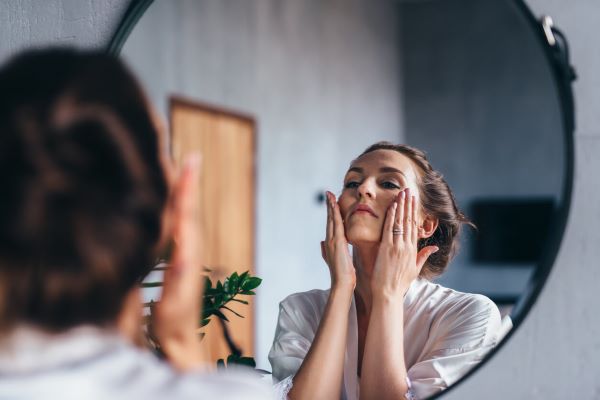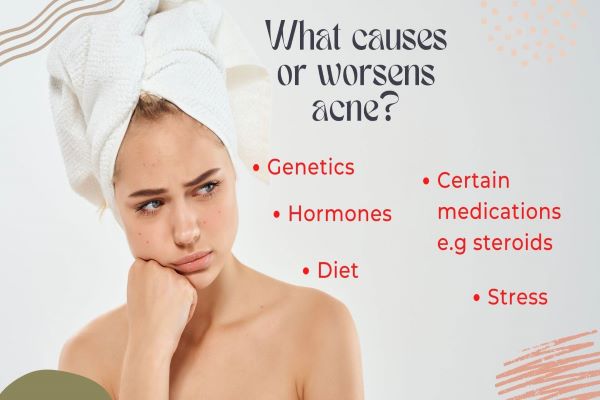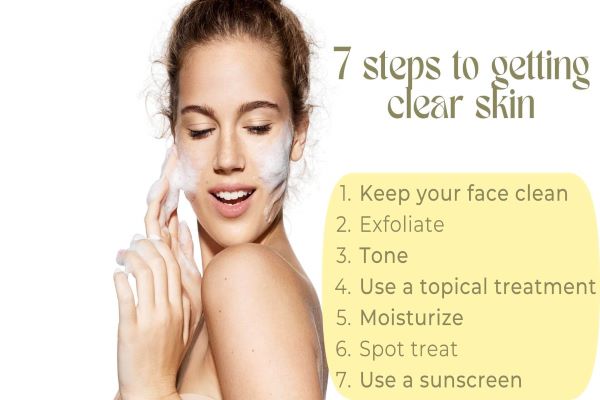
Let’s be real here, most of us want clear skin. Well, unless you’re one of those lucky people who have never had to deal with acne, then good for you! For many people, finding the best acne skin care routine is a life-long journey. Lucky for you though, I’m going to share with you 7 steps that will help clear your skin up! Just kidding. There is no one magic solution when it comes to acne. But hopefully, these tips will give you a good place to start. Happy CLEARING! mic drop
Keep reading to find out ways to help you establish the best acne skin care routine, and how you can be on your way to keeping acne breakouts under control!
What is acne and what causes it

Acne is a skin condition that occurs when the pores become clogged with oil and dead skin cells. This can happen when the sebaceous glands produce too much oil, which can then mix with bacteria and dead skin cells. This can cause any of the different forms of acne as follows; blackheads, whiteheads, papules, and pustules, and in severe cases, nodules or cysts can form.
Acne can be caused or aggravated by a variety of things, including;
- genetics,
- hormones,
- diet,
- certain medications, and
- stress.
Acne is most common in teenagers and young adults but can occur at any age. It is important to treat acne early to prevent scarring.
Acne skin care routine: 7 steps to getting clear skin

There is no one-size-fits-all approach to treating acne, as the best way to treat it will vary from person to person.
However, there are a few general tips that can help to get clear skin:
#Step One: Keep your face clean
The first step in any good skin care routine is cleansing. You should wash your face twice a day with a mild cleanser.
When it comes to acne-prone skin, it is important to choose a gentle, non-stripping cleanser. Look for one that contains hydrating ingredients like glycerin or hyaluronic acid.
Gently massage the cleanser into your skin, using circular motions. Avoid scrubbing your face too hard, as this can irritate the skin and make acne worse. Rinse with lukewarm water and pat dry.
Be sure to remove all makeup before you go to bed.
#Step Two: Exfoliate
Exfoliating helps to unclog pores and remove dead skin cells that can contribute to breakouts. But be sure to use a gentle exfoliator a couple of times a week, as harsh exfoliants or scrubs can irritate the skin and make acne worse.
Look for an exfoliator with gentle beads or particles, like jojoba beads. Gently massage the exfoliator into your skin in circular motions and rinse with lukewarm water.
#Step Three: Tone
Toners help to remove excess oil and balance the pH of the skin. But be sure to choose a non-drying toner that contains hydrating or pore-refining ingredients like glycerin or witch hazel.
Apply the toner to a cotton pad and swipe it over your face, avoiding the eye area. Let the toner dry before moving on to the next step.
#Step Four: Apply a topical acne treatment
There are a variety of over-the-counter topical treatments that can help to treat and prevent acne breakouts.
Look for products that contain benzoyl peroxide, salicylic acid, retinoids, or niacinamide. Apply the topical treatment to the affected area according to the package directions.
#Step Five: Moisturize
It may seem counterintuitive, but even acne-prone skin needs a moisturizer to stay healthy and balanced.
It is also important to moisturize even if you have oily skin. Acne treatments can often make the skin dry, so using a moisturizer will help to combat this.
Look for a light, oil-free, non-comedogenic (meaning it won’t clog pores) moisturizer that contains hydrating ingredients like hyaluronic acid or glycerin.
Apply the moisturizer to your face and neck, using gentle circular motions.
#Step Six: Spot Treat
For pimples that pop up, a spot treatment can be helpful. Look for one that contains benzoyl peroxide or salicylic acid, which are both ingredients that help to kill bacteria and dry up pimples. Apply the spot treatment to the affected area with a cotton swab or pad.
Let it dry before applying makeup (if you have to) or sunscreen over top.
Do not rinse off.
Repeat this process as needed until the pimple clears up.
#Step Seven: Apply a sunscreen
Sun exposure can aggravate acne and increase the risk of scarring. Be sure to apply a broad-spectrum sunscreen with an SPF of 30 or higher every day, even if you’re just staying indoors.
– See a dermatologist
If you’re struggling to get your acne under control, see a board-certified dermatologist. They can prescribe oral medication or stronger topical treatments.
By following these steps, you will be on your way to clear skin!
How to find the best acne skin care products for you
Finding the best acne skin care products for you can be a daunting task. With so many products available, it can be tough to know which ones are right for you. Here are a few tips to help you find the products that will work best for you:
1) Talk to your dermatologist
If you’re struggling to find a product that works, talk to your dermatologist. They can prescribe oral medication or stronger topical treatments.
2) Do your research
Take the time to read reviews of different acne products before you buy them. This will help you to find the products that are most likely to work for you.
3) Try a variety of products
It may take some trial and error before you find the right products for your skin. Try a variety of acne treatments until you find one that works well for you.
4) Stick with it
It may take a while for your skin to clear up completely. Be patient and stick with your treatment plan.
By following these tips, you should be able to find the best acne skin care products for you!
The best way to treat acne

Acne can be frustrating and embarrassing, but it is possible to get clear skin by using the right products and following a routine. We’ll show you how!
The best way to treat acne is to find a product that works well for your skin type and stick with it. It may take some trial and error before you find the right products, but it’s worth it in the end.
Be patient and stick with your treatment plan, and you should start to see results soon.
How to stick to your routine
When it comes to acne skin care, it’s important to stick to a routine in order to see the best results. But sticking to a routine can be tough, especially when you’re busy. Here are a few tips to help you stick to your routine:
1) Make a schedule
If you find it difficult to remember to do your skin care routine every day, try making a schedule. Write down what time of day you will do each step of your routine and put it on your refrigerator or bathroom mirror. This will help you to stay on track.
2) Set reminders
If you have trouble remembering to do your skin care routine, set reminders on your phone or computer. There are a variety of apps and programs that can help you stay on track.
3) Find a partner
If all else fails, find someone who can help you stick to your routine. Ask a friend or family member to remind you each day or even join in on your skin care routine if that person is also acne-prone. This can help to make it more fun and enjoyable.
4) Don’t be too hard on yourself
It’s important to be patient when it comes to acne skin care. It can take several weeks or even months to see results. If you have a breakout, don’t get too discouraged. Just keep up with your routine and you will eventually see results.
By following these tips, you can help to make sure that you stick to your acne skin care routine and see the best results!
The best over-the-counter ingredients for acne-prone skin
If you have acne-prone skin, it can be tough to find the right products to keep your skin clear. There are a variety of products available, but not all of them are effective for acne-prone skin. Here are a few of our favorite products:
1) Salicylic acid
Salicylic acid is a chemical peel that helps to exfoliate the skin and clear pores. It is a common ingredient in over-the-counter acne treatments.
2) Benzoyl peroxide
Benzoyl peroxide is a common ingredient in acne treatments and helps to kill bacteria and reduce inflammation.
3) Retinoids
Retinoids are vitamin A derivatives that help to clear pores and reduce inflammation. They are available over-the-counter. Your dermatologists can also prescribe stronger formulas.
4) Tea tree oil
Tea tree oil is an oil derived from tea tree leaves that has anti-inflammatory and antibacterial properties. It can be used as a spot treatment for acne breakouts.
5) Niacinamide
Niacinamide is a form of vitamin B3 that helps to brighten the skin and reduce inflammation. It is a common ingredient in over-the-counter acne treatments.
6) Clay masks
Clay masks help to absorb excess oil and clear pores. They can be used weekly to help keep skin clear.
By using these products, you can help to keep your skin clear and free from acne breakouts!
Conclusion
Just remember that everyone’s skin is different, so what works for one person might not work for another. Be patient and don’t give up if you don’t see results right away. And as always, consult a dermatologist if you’re struggling to get your acne under control.
With the right products and a little patience, you can get clear skin!
Leave your comments below!
We would love to hear from you on what has worked for you when it comes to clearing acne and getting clear skin! What are your favorite products? What tips do you have for others? Leave your comments below!
Disclaimer: This article is not intended to be medical advice. If you have any questions or concerns about your skin, please consult a dermatologist.
